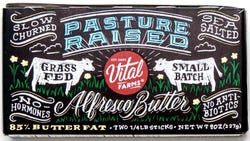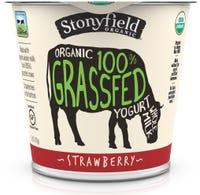Non-fat milk, out. Full-fat dairy, in.Non-fat milk, out. Full-fat dairy, in.
Here's why natural brands are making a bet on full-fat cheese, yogurt, milk and butter.

You pour it over cereal. You eat it on a bagel. You munch it with granola. And sure, sometimes you give it to your cat.
We’re talking of course about dairy, the oft-beloved, occasionally vilified category that’s contentious within the natural industry—some health experts say dairy is healthy; some say it's the root of myriad health conditions like chronic inflammation.
Vegan food and beverage brands are currently the darlings of the natural industry, and clean dairy alternatives that employ nuts and plant proteins are earning ample media attention (and impressive investment backing). But the reality is that dairy continues to be an important player in U.S. diets. In 2014, Americans ate a whopping 614 pounds of dairy per person, according to the USDA. In this category, milk, yogurt and cheese comprised the majority of dairy products, with ice cream in a close fourth. Dairy consumption has risen over the past decade, but what has changed the most is the kind of dairy we’re eating and the ideological factors driving such eating patterns.
Now, natural dairy consumers are interested in where milk came from, what the cow ate and, notably, whole-milk products. Increasingly more brands are tapping into such desire for fat-containing dairy items to both dispute the idea that fat is evil and to promote a whole-food diet that focuses on holistic nutrition. 
“For years, conventional wisdom was that a diet low in fat was the best way to stay healthy,” says Dan Brooks, creative director for Vital Farms, a conscious company launching a butter SKU that contains 85 percent fat. He adds that the newest slew of studies suggest that eating whole-milk products may even help stave off obesity. This research, paired with high-profile, fat-focused diets like Bulletproof (which encourages followers to stir butter, ghee or coconut oil into morning coffee), ketogenic and paleo, has contributed to the notion that, fat, well, doesn’t make you fat. Rather, eating fat keeps you full for longer. “The current popularity in high-fat diets is still just the beginning, but hopefully widespread acceptance is not far off,” Brooks continues.
Stonyfield Organic, too, is passionate about getting consumers to hop on the whole-milk wagon. The brand recently announced the launch of three new organic yogurt options—all of which feature whole-milk (and in one case, PCO-certified 100 percent grassfed milk). Ana Milicevic, Stonyfield’s whole milk brand manager, says shoppers are interested in whole milk products because they’re more attune to the idea of healthy balance eating, rather than focusing on eliminating or lauding one specific macronutrient. “Today what’s prevalent in consumer attitudes is a view of food as a way to proactively control your health, and to put in place those investments now that will let you stay healthy in the long term,” she says, adding that this sentiment is especially popular with millennial shoppers.
in whole milk products because they’re more attune to the idea of healthy balance eating, rather than focusing on eliminating or lauding one specific macronutrient. “Today what’s prevalent in consumer attitudes is a view of food as a way to proactively control your health, and to put in place those investments now that will let you stay healthy in the long term,” she says, adding that this sentiment is especially popular with millennial shoppers.
Another reason Milicevic is excited about the new line: Whole milk is really, really delicious. As cooking and food-forward television shows, competitions, cookbooks and blogs continue to capture audiences, boosted flavor is no small advantage. “When you look at the way we entertain ourselves now, there really is a gravitas when it comes to delicious food and flavor. Whole milk is delicious—now science is starting to give us a reason that it’s healthy.”
Vital Farm’s Brooks agrees. “The human palette is well tuned to the presence of fat … so it's not just a fleeting note of flavor, but a deeply satisfying symphony of taste that you get with Alfresco Butter.”
That’s something we can get excited about, too.
About the Author
You May Also Like





